Idaho is located in the Pacific Northwest of the United States and is known for its diverse habitats, which include the Snake River plain and a stretch of the Rocky Mountains. Idaho has a vast array of wildlife, including twelve different species of snakes. Many of these snakes are black or have distinctive black markings, so this article will help you to identify the black snakes in Idaho as you enjoy your time in the great outdoors.
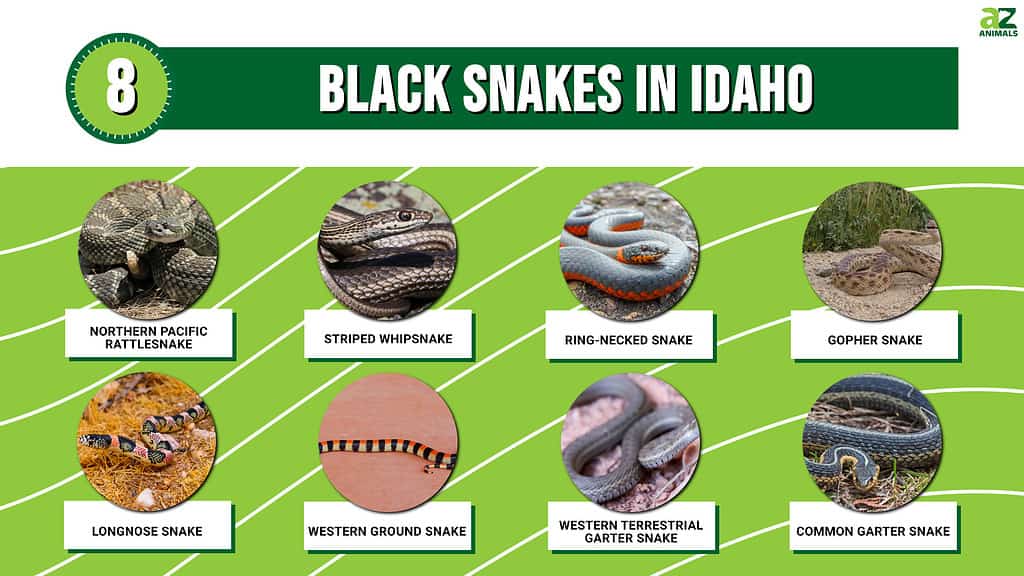
1. Northern Pacific Rattlesnake (Crotalus oreganus)
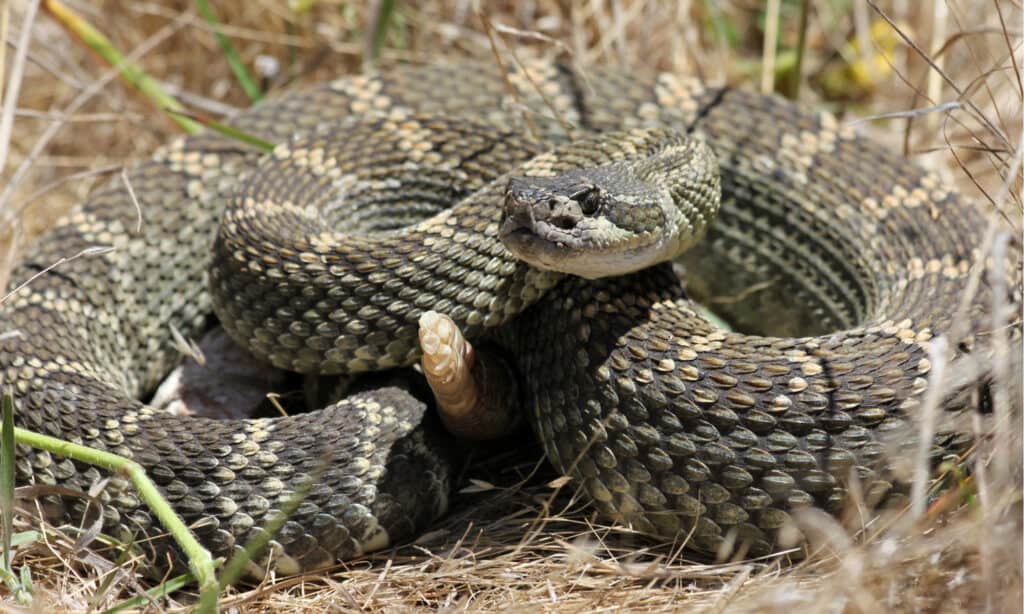
Northern Pacific rattlesnakes are highly venomous.
©Ryan M. Bolton/Shutterstock.com
We’ll kick off the list with the only dangerous black snake in Idaho – the northern Pacific rattlesnake. Northern Pacific rattlesnakes live in the lower two-thirds of the state, typically on rocky hillsides or rocky areas near streams and forests. Their appearance and length can vary, but most are around 3 feet long and are dark grey, brown, or black with large blotches which are edged with white. Northern Pacific rattlesnakes are venomous pit vipers and eat a range of birds, small mammals, reptiles, and amphibians. They are highly venomous, so if you are bitten by one, it is important to seek medical attention immediately.
2. Striped Whipsnake (Masticophis taeniatus)
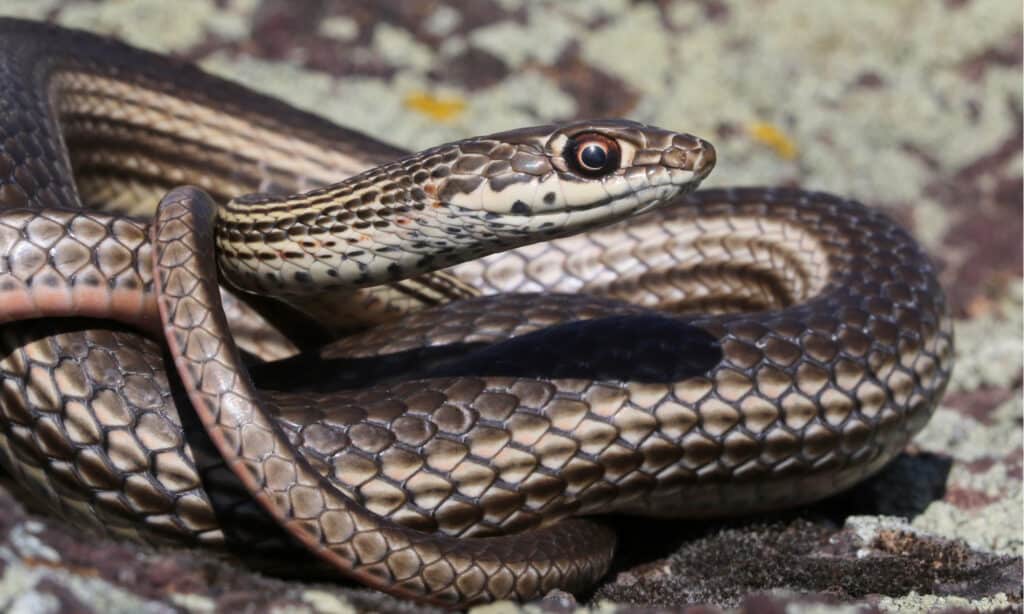
Striped whipsnakes can become aggressive if disturbed or threatened.
©Randy Bjorklund/Shutterstock.com
Striped whipsnakes are fast, agile snakes that live in a wide variety of habitats – including grasslands, shrublands, forests, and deserts. However, in Idaho, they are restricted to only the bottom third of the state. Striped whipsnakes are 30 to 72 inches long and are typically black, grey, or blueish-green with light-colored stripes down their sides. They are not venomous and prey on a wide range of animals, including other snakes. However, if they are disturbed or threatened, they can become aggressive and will bite.
3. Ring-Necked Snake (Diadophis punctatus)
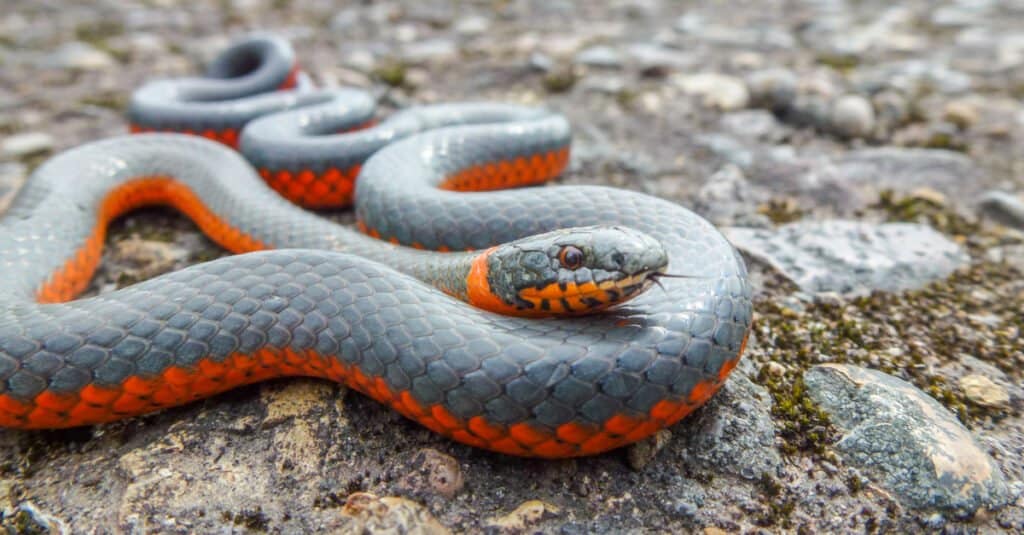
Ring-necked snakes have slender bodies and are black or grey with a bright ring of color around their neck.
©Tom Fenske/Shutterstock.com
Another black snake in Idaho is the ring-necked snake, which is one of the smallest snakes in the state, at only 10 to 20 inches long. Ring-necked snakes have slender bodies and are black or grey with a bright ring of color around their neck which is typically red, orange, or yellow. Their bellies may be the same color as their neck ring. Ring-necked snakes are usually found on open hillsides or forested regions, and they are distributed across most of the state. These snakes are mildly venomous to their prey, although they are not dangerous to humans. They are shy and secretive and move quickly, so you are not likely to encounter them anyway.
4. Gopher Snake (Pituophis catenifer)
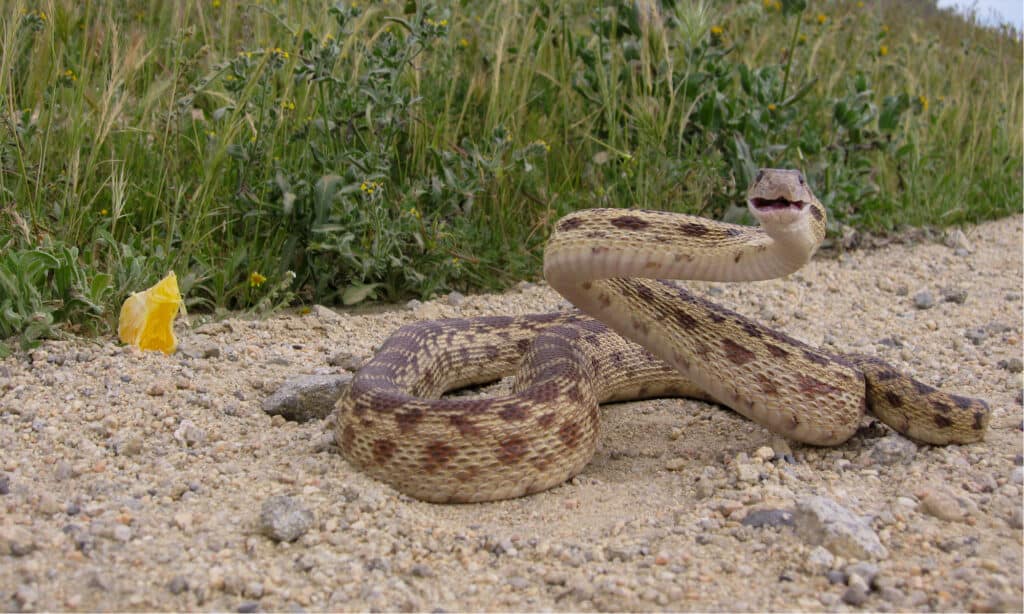
Gopher snakes are among the largest snakes in Idaho.
©rawaccess/Shutterstock.com
Another black snake in Idaho is the gopher snake which is one of the most common snakes in the state. However, despite being most likely to be encountered in the state, gopher snakes are not found in the northernmost counties. Gopher snakes live in a wide variety of habitats – including deserts, mountainous regions, and farmland. They are among the largest snakes in Idaho and reach 5 to 6 feet long. Gopher snakes are typically a yellowish or pale brown color with dark brown or black spots and blotches. They are not venomous and eat mainly rodents and birds. However, juvenile gopher snakes also eat insects and lizards.
5. Longnose Snake (Rhinocheilus lecontei)
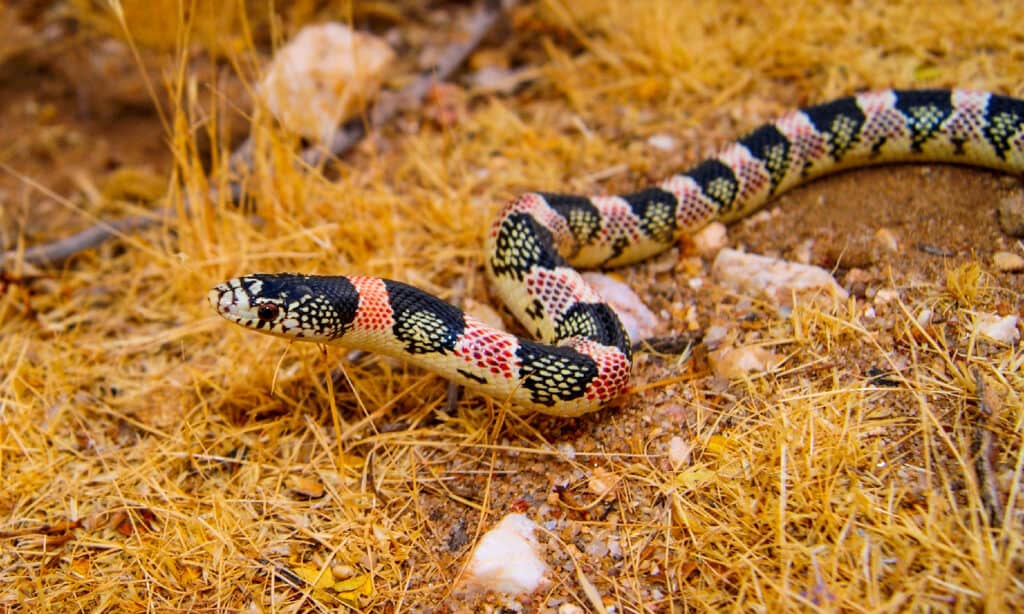
Longnose snakes have black and red markings on a yellowish background.
©Matt Jeppson/Shutterstock.com
Although the longnose snake is not venomous, it is often mistaken for the venomous coral snake because of its similar appearance. Longnose snakes have black and red markings on a yellowish background but have a distinctly long and upturned snout. They are typically 22 to 33 inches long, although the longest recorded specimen was 41 inches. These snakes are particularly apt at burrowing. They spend most of their time in areas with plenty of loose, sandy soil – often desert regions.
In Idaho, longnose snakes usually live in the deserts of the southwest but can also sometimes occur in Burley in the south. Longnose snakes are nocturnal, so it is unlikely that you will see them, but if you do encounter one then they have a habit of releasing a foul-smelling musk when they are threatened.
6. Western Ground Snake (Sonora semiannulata)
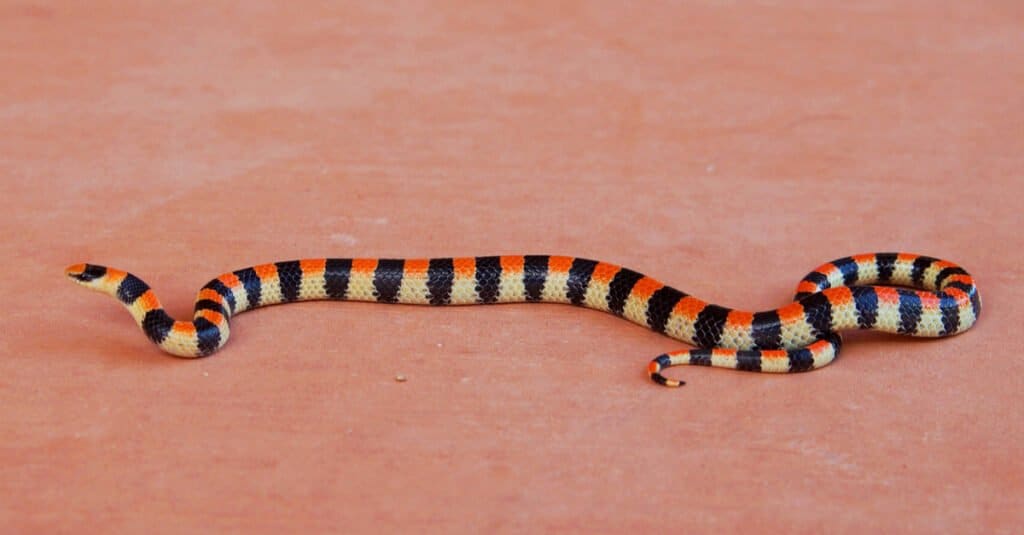
Western ground snakes are shy and secretive snakes.
©Matt Jeppson/Shutterstock.com
A snake with a particularly striking appearance is the western ground snake, which typically has black banded markings alternating with red, brown, or orange. Western ground snakes are small snakes and reach only 8 to 19 inches long. Due to their small size, they only prey on small animals – mainly invertebrates such as insects, spiders, and scorpions. They are shy and secretive snakes and live in areas with talus slopes, rocky outcrops, or desert shrubland with sandy soil. They are only found in the southwest region of Idaho – mainly along the Snake River.
7. Western Terrestrial Garter Snake (Thamnophis elegans)
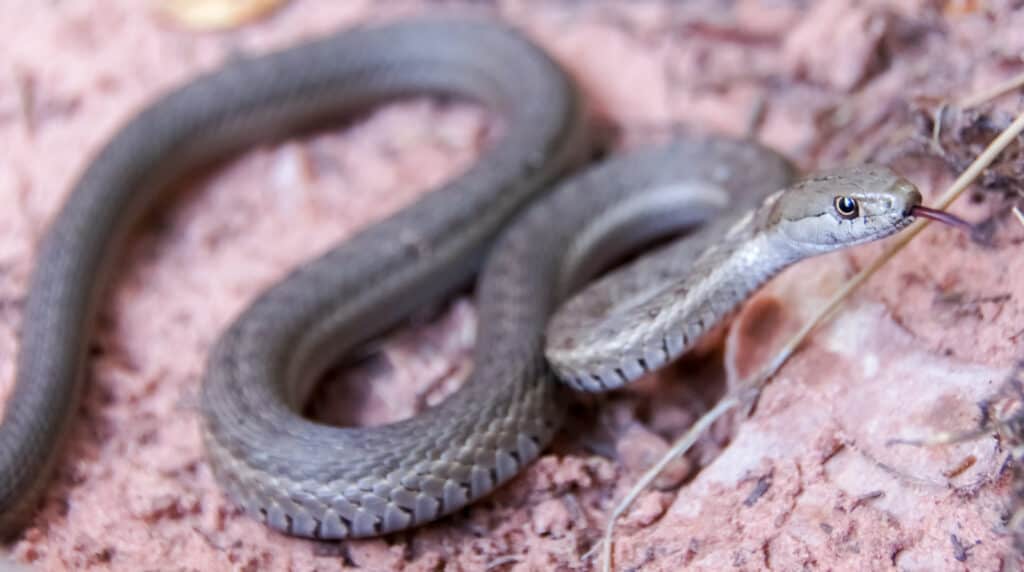
Western terrestrial garter snakes can be found near water and are semi-aquatic in some populations.
©iStock.com/yhelfman
Western terrestrial garter snakes are typically 18 to 41 inches long and have a widely varied appearance. They are usually a greyish-green color with a yellowish dorsal stripe and a lateral stripe on each side of their body, sometimes with black spots between their dorsal stripes. Occasionally, these snakes can be entirely black (melanistic). They have keeled dorsal scales. Western terrestrial garter snakes are found across the entire state of Idaho, where they live in a range of habitats – including deserts, grasslands, mountains, and forests. They can also be found near water and are semi-aquatic in some populations. Western terrestrial garter snakes contain mild venom in their saliva, and bites can cause localized swelling.
8. Common Garter Snake (Thamnophis sirtalis)

Common garter snakes have a black, brown, or dark green base color with yellow or cream-colored stripes.
©iStock.com/Wildnerdpix
The final black snake in Idaho is another garter snake – the common garter snake. Common garter snakes are distinguishable from western terrestrial garter snakes by their darker appearance. Common garter snakes have a black, brown, or dark green base color with yellow or cream-colored stripes. They also often have red markings along their sides.
Common garter snakes are long and can reach around 52 inches. They often live near bodies of water, such as streams, rivers, lakes, and swamps. However, they can also be found in grassland and forests. Despite their name, they are not quite as common in Idaho as western terrestrial garter snakes, yet they are still distributed across the majority of the state. They are mainly diurnal snakes and are active from March to October.
Summary of 8 Black Snakes in Idaho
| Number | Spider |
|---|---|
| 1 | Northern Pacific Rattlesnake |
| 2 | Striped Whipsnake |
| 3 | Ring-Necked Snake |
| 4 | Gopher Snake |
| 5 | Longnose Snake |
| 6 | Western Ground Snake |
| 7 | Western Terrestrial Garter Snake |
| 8 | Common Garter Snake |
The photo featured at the top of this post is ©
Discover the "Monster" Snake 5X Bigger than an Anaconda
Every day A-Z Animals sends out some of the most incredible facts in the world from our free newsletter. Want to discover the 10 most beautiful snakes in the world, a "snake island" where you're never more than 3 feet from danger, or a "monster" snake 5X larger than an anaconda? Then sign up right now and you'll start receiving our daily newsletter absolutely free.
Sources
- Digital Atlas Idaho, Available here: https://digitalatlas.cose.isu.edu/bio/reptile/serp/dipu/dipufram.htm
- Digital Atlas Idaho, Available here: https://digitalatlas.cose.isu.edu/bio/reptile/serp/mata/matafram.htm
- Digital Atlas Idaho, Available here: https://digitalatlas.cose.isu.edu/bio/reptile/serp/rhle/rhlefram.htm
- Digital Atlas Idaho, Available here: https://digitalatlas.cose.isu.edu/bio/reptile/serp/thel/thelfram.htm
- Digital Atlas Idaho, Available here: https://digitalatlas.cose.isu.edu/bio/reptile/serp/thsi/thsifram.htm
Thank you for reading! Have some feedback for us? Contact the AZ Animals editorial team.






